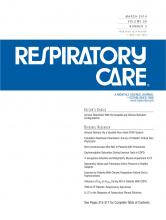In Reply:
We appreciate the salient observations and comments by Hadda et al. It is our sincere hope that this response provides the necessary data and clarification to guide future applications of our study results in the care of patients with COPD.
Although we concur that noninvasive ventilation (NIV) is an important modality in the acute care of patients with COPD exacerbation, our research protocol was not intended to modify or change our institutional standard of care for the purpose of this study. Though the use of NIV in acute care is increasing, its use is still low in some countries. There have been no reports on the use of NIV for COPD exacerbations in our institution; however Ambrosino et al found that in 20–52% of hospitals in European countries, NIV was unavailable, and its utilization rate was 15–80% in patients with COPD exacerbation.1
Pursuing a randomized controlled trial methodology in our study, we hoped to minimize the impact of different treatment methods on the study outcome, and to compare and measure the effects of inhaled furosemide in each group. However, our methodology, and randomized controlled trials in general, often deal with very highly selected patients and assess care patterns that do not necessarily fit each and every institution. In addition, randomized controlled trials are usually too small and of too short duration to permit evaluation of delayed effects of the studied treatment. Therefore, integration of this practice in the clinical care of patients may require further multi-institution investigations.
Many clinicians feel apprehensive about conducting spirometry, because of uncertainties about performing and interpreting it, and about the patient's cooperation in the tests. In our study we had concerns regarding the clinicians' technical ability to perform the test and interpret the results. We were able to execute the tests, as we reported, by providing appropriate training and extra efforts. The Global Initiative for Chronic Obstructive Lung Disease international COPD guidelines2 advises spirometry to measure lung function. We used spirometry to quantify breathlessness in our subjects, with or without the intervention.
Hypoxemia is defined as PaO2 of < 55 mm Hg or oxygen saturation of < 90%.3 Oxygen therapy should be deliberately provided in patients with COPD. However, in patients with SpO2 of < 90%, the oxygen should be titrated to achieve SpO2 of 90%.4 In our study the mean oxygen saturations in the intervention and control groups were 84.8 ± 9.6% and 82.8 ± 4.7%, respectively. Regarding equal treatment, we considered 0.5 L/min oxygen for 30 min for all these hypoxemic patients as the standard treatment, and the decision on the continuation of oxygen therapy was made by a physician for every patient individually, according to standards of COPD treatment.
Acknowledgments
We thank Bita Pourmand, Research Development Center, Sina Hospital, Tehran University of Medical Sciences, Tehran, Iran, for her careful edit of the manuscript.
Footnotes
The authors have disclosed no conflicts of interest.
- Copyright © 2014 by Daedalus Enterprises











